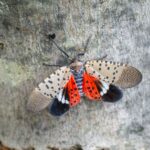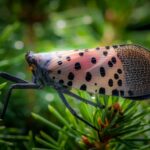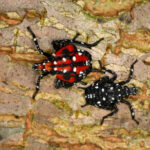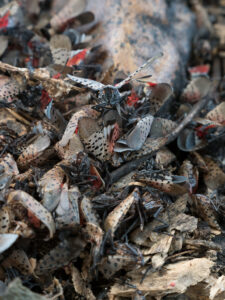A dangerous pest is threatening Canada. A voracious sap sucker, this southeast Asian native has the potential to cause catastrophic damage to both Canada’s agricultural industry, and its natural environment. This threat is known as the spotted lanternfly (SLF).
What is the spotted lanternfly?
SLF is a plant hopping insect from southeast Asia, who has become a problematic invasive species in the United States and Korea. While juveniles are only capable of jumping, adults also possess the ability to fly short distances and glide on the wind.
What does the spotted lanternfly look like?



SLF has a very distinctive appearance. Adults are 2.5 cm long and have grey wings with black spots. When they open their wings, the underside is bright red.
Young nymphs begin with black with white spots and become more reddish as they mature. Spotted lanternflies undergo four life stages (instars) before they become adults. The first three life stages are black with white spots and look similar except for increasing size. By their fourth life stage they become significantly larger, about 1.25 cm, and their coloring turns bright red with black and white spots.
Eggs are brown, seed-like, and are covered by a greyish secretion to from an egg mass that is arranged in an oval shape vertically.
Are spotted lanternflies in Canada yet?
No. So far, they have only been identified in the United States. They were first identified in Pennsylvania in 2014 and are now found in 11 different states across the US.
As of now, SLF are considered a species of alert in Canada, and their spread is being carefully monitored by the Canadian Food Inspection Agency (CFIA).
What are the risks associated with spotted lanternflies?

These insects pose great risk to North America’s agricultural industry. While their preferred source of food is the tree of heaven, a southeast Asian tree considered invasive to North America, they’re also known to feed on grape vines, tender fruits trees, and over 100 other tree varieties, some of which are important in forestry and agriculture.
The Canadian wine and grape industry contribute $9 billion in economic impact to the Canadian economy. This industry employs over 37,000 people and generates 1.7 billion in tax revenue. Canada’s tender fruit industry also contributes millions of dollars to the economy.
The introduction of the spotted lanternfly could devastate these industries. Pennsylvania has seen significant damage to its wine and fruit industry. Officials estimate that if the infestation isn’t controlled, Pennsylvania alone could see millions of dollars in lost revenue.
Further, spotted lanternfly nymphs happily eat native trees, including maple, birch, and willow trees. While SFL feeding will not necessarily kill trees, it weakens the trees, making them more susceptible to disease.
SLF also secrete a sweet substance called honeydew that causes mold patches on the tree and attracts other insects. Weakened already by SFL attack, the tree is less capable of defensing itself from other insect’s assault.
What is being done to prevent the spread of spotted lanternflies?
SFL was added to the CFIAs regulated pest list in 2018 to prevent its introduction and spread from infested areas. The CFIA is also putting in place additional import requirements on high-risk plants and plant products originating from infested US states.
Awareness and reporting campaigns are ongoing by all levels of government and non-profits across Canada and the US.
How can you help prevent the spread of spotted lanternflies?

Diligence of the public is essential in preventing the spread of spotted lanternflies. Here is what you can do to help:
- Report sightings to the Canadian Food Inspection Agency at www.inspection.gc.ca/pests (find your provincial or territorial reporting information at reportcanadainvasives.ca)
- Look for hitchhikers – lanternflies aren’t very good fliers, but they are very good at hitching rides on cars and any other object being transported.
- Scrape off and destroy egg masses – moving egg masses to new locations is a major way of establishing new populations. SLF overwinter in the egg life stage. Each egg mass can contain 40-50 eggs, potentially kickstarting a new infestation wherever they hatch. Egg masses can be destroyed by crushing them in rubbing alcohol, hand sanitizer, or soapy water.
- Remove tree of heaven from your yard – These trees are a popular ornamental tree and are a host for lanternflies. Removing tree of heaven will help slow SLF’s ability to find hosts and spread. Individuals can report sighting of the tree of heaven on your local reporting platforms. This information will be useful in detection and response actions.
Stay on the lookout for invasive species or species you’re unfamiliar with, and help protect our industry, native ecosystems, and communities.

